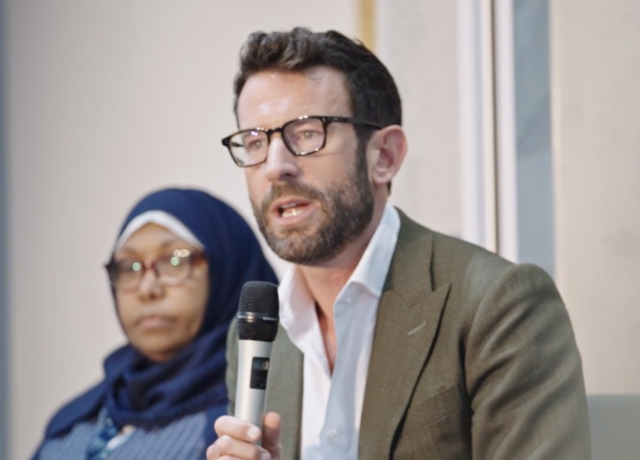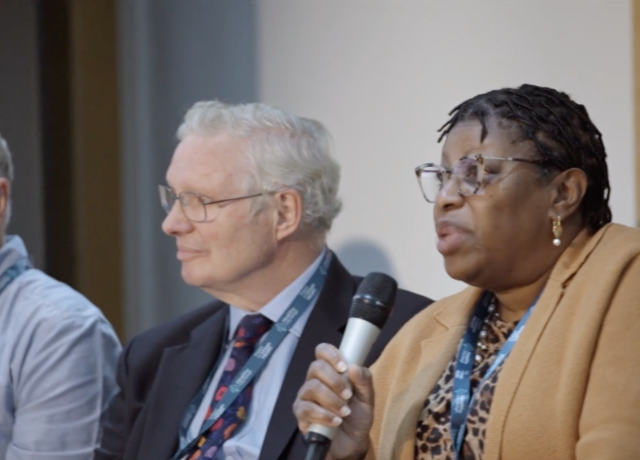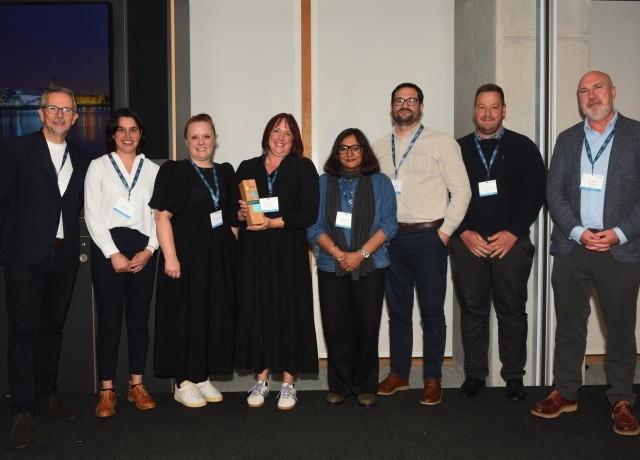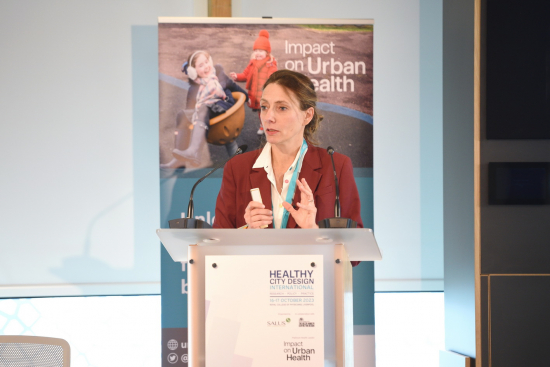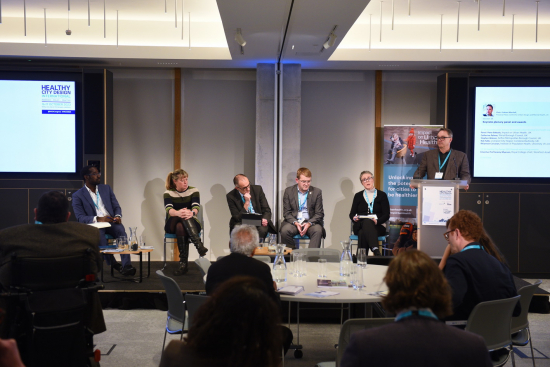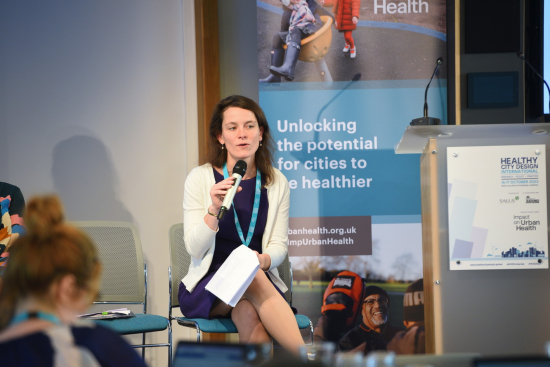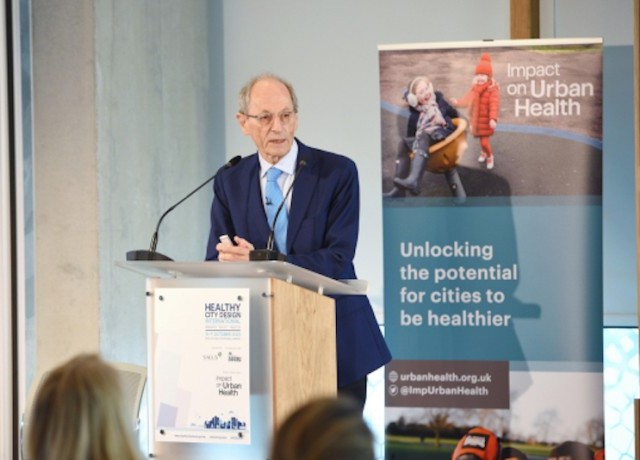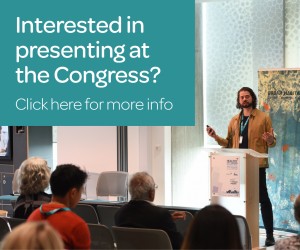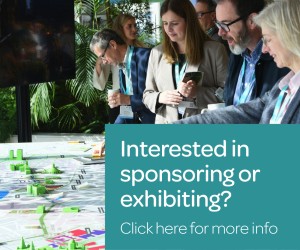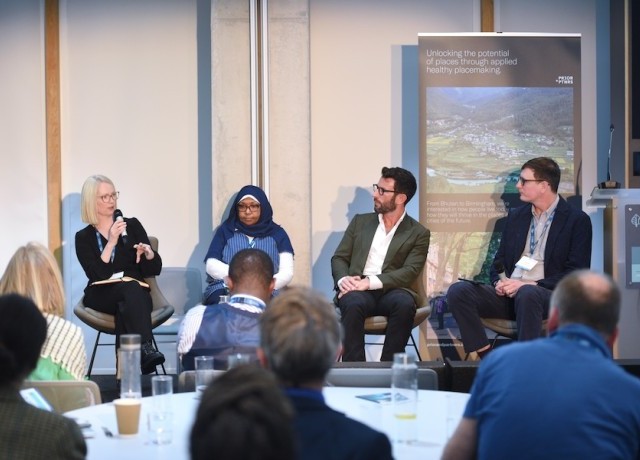
Keynote summary: Advancing health equity through place-based impact investing
The closing plenary on day one of Healthy City Design 2024 considered the role of place-based impact investing, which is gaining momentum as a powerful strategy to unlock capital at scale to address public health outcomes.
The session was organised by the Impact Investing Institute – an independent, not-for-profit organisation with a mission to make capital markets fairer for people, places and planet.
As chair Mark Hall, a senior programme manager, explained, the Institute advocates for “place-based impact investment, which is an approach to investing which seeks to deliver measurable and intentional social and environmental impact, tailored to the unique contexts and tapestries of places, alongside delivering financial returns for investors, to deliver inclusive and sustainable communities and healthy places”.
Pete Gladwell, group social impact and investment director at Legal & General, explained that health and how we address health equity is a really important topic but one that has been under-examined and considered by the investment sector historically. He described how the company got into this space through learning about Sir Michael Marmot’s work and the Institute of Health Equity at UCL. It has since forged strong links with the Institute and described three elements to have come out of it so far.
The first is a joint report on the role of business in tackling health inequality. Gladwell shared three key scopes for business to address health inequality: how it treats its employees; the products and services it produces; and its role as an anchor institution and the influence it has.
“Healthy cities are a really important part of the products and services Legal & General produces, such as investing in over 500 social and affordable homes, a key determinant of health equity.”
A second element of the partnership is the Healthy Equity Network, which L&G set up with Sir Michael Marmot, to enable local place-based organisations, the NHS, and local authorities to come together to address health inequalities. Thirdly, he emphasised that investment in this space can’t only be commercial. “There’s a need for charitable investment, too,” he said. “We’ve set up a £3m health equity fund, which provides grants for community initiatives, charities, etc.”
The missing 20 per cent
Dr Muna Abdel Aziz, director of public health for Salford, at Salford City Council, talked about reaching out to vulnerable communities. “We’ve got plenty of research that tells us it’s the wider determinants of health that influence the health of people. Some of the questions we always ask are: who are we missing? The loudest voices are not the ones who need it the most.”
She added: “We’ve got an approach that says, ‘we’re doing a good job’. It’s 80 per cent good enough but who are the 20 per cent we’re missing? That’s worked with our planning colleagues, it’s worked with our health and care colleagues, so we’ve got the start of a really good story here.”
Jo Harrop, director of social enterprise PLACED, explained her organisation’s role in translating the conversation between policymakers, designers, those with the money, and the communities who understand their local areas and have the ideas and the solutions but don’t necessarily have the pathways and the routes to exert influence.
For Legal & General, the drive is investing into places to improve people’s healthy life expectancy, economic growth, and developing healthy places that enable people to thrive.
Said Gladwell: “If we understand the need to invest in a place, and we work collaboratively with the combined authority, the local authority, local community organisations, universities, then when we invest to meet that need, then we’ll create assets that society needs, and we’ll get a better long-term risk-adjusted return. We’ll get better, more robust cash flows to pay people’s pensions, because we’ve created an asset that that society actually needed. So, there is both a social role in this and a commercial rationale.”
“There is both a social role in this and a commercial rationale”
Where impact is happening
Moving on to some examples of where tangible impact though investment can be seen, Gladwell highlighted the project of Newcastle Helix, a partnership with the city council and the university.
“They had this fantastic vision for a place that did drive health equity, both in terms of the university startups, which specialise in this area, sustainability, ageing, but they needed serious investment, about £300m, to bring forward this whole ecosystem,” said Gladwell. “We’ve invested hundreds of millions of pounds into that site – lots of CO2 has been saved, lots of positive social impact, and it’s really driving the local economy in a positive way while enabling those start-ups to scale up.”
Dr Aziz talked about the Salford Quays 2030 Plan – a framework and vision to create a vibrant and convenient town centre offering; development of more commercial office space; and delivery of high-quality and affordable homes within attractive, landscaped neighbourhoods.
“What we’re trying to do is to understand what the challenges are right now but also for the future,” she said. “Where it intersects with investment, regeneration, let’s talk about the timescales. When I was talking to our regeneration colleagues in the council, they said, ‘If you want to be involved in the masterplanning, you’ve missed the boat because we’ve masterplanned already to 2030’. I said, ‘I’m trying to masterplan for health to 2030’.
“So, the conversation has been: what are our timescales and your timescales? We’re on a journey now around, for example, our estates, where we have regeneration, new build. It’s checking in with our GPs and our pharmacies to ensure we’ve got the infrastructure for health and care alongside that new build.”
She added that the catchphrase that has resonated with people is ‘Thriving in Salford’ – as this touches everyone, individuals, communities, and businesses, creating a positive holistic image of the development.
 (l to r): Jo Harrop; Dr Muna Abdel Aziz; Pete Gladwell; Mark Hall
(l to r): Jo Harrop; Dr Muna Abdel Aziz; Pete Gladwell; Mark Hall
Community hub
Harrop explored working with several teams to engage communities on different projects to deliver the Birkenhead 2040 framework – noting how there was not a joined-up, cohesive conversation. Alongside that, there was levelling up funding alongside development and masterplans and frameworks, at the same time that cuts were being made to the services that those communities really valued.
In partnership with the council, we set up a community engagement hub, which PLACED ran across a 12-month period. This was a space where people knew where to come to talk about their town, how they could influence change, and how their voice mattered in that process.
“Over that time, 12 projects came through that space, and we were able to ensure a cohesive level of conversation and involvement within all of them,” said Harrop.
More than 200 days of volunteer support was delivered, along with 60 different events to try to reach out and bring people in who weren’t coming to the space. Outreach included people with learning disabilities, recognising that there was a barrier to access with such groups, as well as primary schoolchildren, and teenage girls to understand their specific needs.
The impact of the hub was considerable, with 99 per cent of the people who came into the space saying they enjoyed it – including some of the most vulnerable people. Ninety-two per cent of people felt able to share their views, and 76 per cent said they felt more part of their neighbourhood.
“Overall, that holistic conversation had so many collective impacts on health, short, medium and long term,” confirmed Harrop.
Offering some advice for local authorities on investing in health equity, Dr Aziz highlighted the importance of knowing your community and understanding the geography. “Because we think of neighbourhoods and communities as being hyper-local when you can have a community that’s across the whole of the country,” she noted.
Another lesson is showing a return in health and investment terms. “It’s actually about positive feasibility, not negative viability,” she said. “If you build it positively with your communities, and you know it’s going to be used. It’s going to be used well, it’s going to be multi-purpose, it’s going to be fit for the future, it’s more likely to be profitable.
“But still, what’s the bottom line? We need to put that in in pound signs and that’s where the challenge is.”
Event news
Advancing health equity through place-based impact investing
7th November 2024
Health 2040 – system working towards a healthier Liverpool
1st November 2024
HCD 2024 Welcome address
1st November 2024



